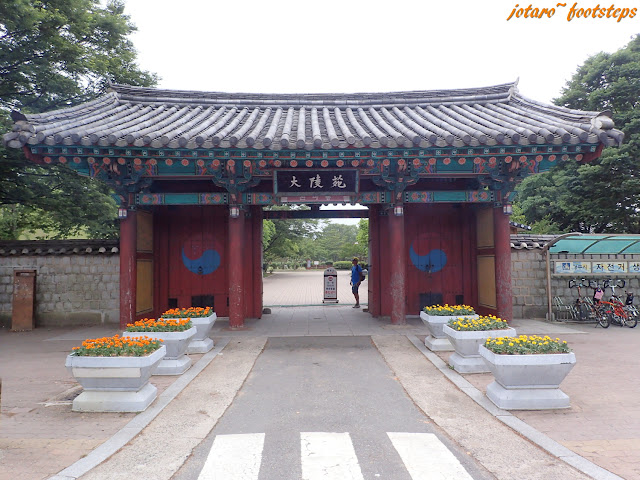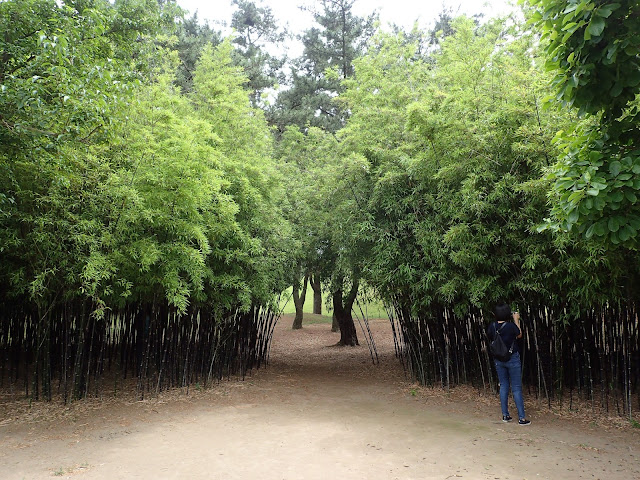You are at - Jotaro's Blog / Footsteps / Korea 2016 - Sites / Tumuli Park Tomb Complex Gyeongju (대릉원)
Footsteps - Jotaro's Travels
I was wondering what they were, but no worries we will be visiting some of them later.
After checking in to our stay in Gyeongju, the Hanok Sodamjeong, we went out straight to the Tumuli Park where the more renown of these mounds were. The park is walled up and we went in via the northern entrance at Taejong-ro where there is a stately roofed gateway. There is another entrance on the east at Gyerim-ro.
A side view of Tumuli Park east entrance gateway, showing some details of the roof eaves and detail painted roof members.
Oh ya... notice the bicycles at the right, those are ours - we were on a short cycling tour of South Korea!
Here's a map of the park to help orientate the locations of some of the photos shown later.
This map shows several tombs within the park; yes Tumuli is not just a park, it is also known as the Daereungwon Tomb Complex. The tombs are those of the kings of the Korean Silla Dyanasty which existed form 57BC to 935AD; and were built during the Maribgan Period of the the dynasty (between the 5th & 6th century).
On entry to the park a pond full of Hyacinths greeted us, behind it were two large connected mounds. These mounds are actually tumulus (plural of which is tumuli) i.e. a mound of earth with raised over a tomb, but there were nothing scary about them. In fact the place really did have a serene and quiet park atmosphere with landscaping all around.
The two mounds seen above was called the Hwangnam Daechong. (the great tomb of Hwangnam). The northern one was burial ground of a man and the southern one that of a woman.
We walked through the park, enjoying the shaded paths with peeks of the mounds through the trees...
... every once in a while, we sat down at benches in the shades of the tree, taking the quiet atmosphere.
The pathways goes through groves of old crooked pine trees ...
... and also bamboo clumps.
With its reedy stems and lush green canopy, the bamboo clumps are a favourite spot for photography.
Let's have a look at the tumuli themselves; the larger ones stood between 10 to 15 metres tall and with a base diameter of up to 30 to 50 metres. Within these larger mounds were burial chambers, we will have a look at the inside one of them later. Some were so large that they could not fit in to a single frame of my photo unless standing from quite a distance away (which sometimes was not possible as trees get in the way).
Some of tumuli were small ones, without any chamber inside.
Most of the larger mounds stand alone...
... while others are connected mounds, like this one which contained the burial chambers of a king & queen.
Some tumuli, although standing individually, were grouped closely together. I am not sure of the significance of these; perhaps this was a family plot.
Some of the smaller ones without any chamber inside had pine trees growing atop.
Through archaeological excavation and research, a couple of these tumuli have been identified. One of this is the Cheonmachong, which was excavated in 1973, it is 47 metres in diameter, 157 metres in circumference, and 12.7 metres in height. The above photo shows the entrance to the inside of the mound.
The tomb is named after the Cheonma, a Korean Pegasus, which was seen in a famous painting of a white horse drawn on a birch bark saddle flap recovered from the tomb.
Like most of the larger tumuli, the inside of the Cheonmachong was hollow. A central stone rubble wall held up a timber-domed roof,above which a thick layer of soil were piled - that is why the larger mounds do not have trees growing on top. Within the wall was a wooden chamber where the coffin of the king was placed. At the perimeter walls were artefacts from Korea's Three Kingdoms era on display, these artefacts and the burial coffin were actually replicas; the real items were on display at the Gyeongju National Museum.
Some of the replica items (originals found during archaeological excavation) on display:
A golden crown.
Brass pots.
A golden wing-shaped diadem.
 |
| Separate entrance gateway to King Michu's tomb. |
Further in was another important tomb, the Michuwangneung (신라미추왕릉); this was the grave of King Michu, who reigned from 262-284AD. He was the 13th ruler of the Silla Kingdom, the first of the Kim clan to sit on the throne.
His tomb here was separately walled up, and the entrance gate was lock. Peeping through a gap in the door, showed an a stone altar in front of the mound. This tumulu was also known as the Jukjangneung, "the Bamboo Chief Tomb", as according legends from the Samgungnyusa (the Memorabilia of the Three Kingdoms -삼국유사), King Michu had his soldiers camouflaged with bamboo leaves to surprise attack his enemy. Later his tomb was stacked with bamboo leaves, to remind the people of this ploy.
The park is serene, at a rear section a hanuk hotel borders one of the walls, these past kings of Korea will guard them well.
TUMULI PARK TOMB COMPLEX
Also know as: Daereungwon Tomb Complex (Cheonmachong Tomb) (대릉원 - 천마총)19, Gyerim-ro, Gyeongju-si, Gyeongsangbuk-do, South Korea.
• 1330 Travel Hotline: +82-2-1330 (English, Korean, Japanese, Chinese)
• For more info: +82-54-779-8796, +82-54-743-1925
Hours: 9:00am to 10:00pm
Entrance fee: Adults - 2,000KRW, Teenagers (13-18yrs) - 1.200KRW, Children (7-12yrs) - 600KRW. Discount available for groups of 30 or more people.
GPS & Direction Map: 35.83964, 129.21082
(Click here for Google Street View)
Related / Similar Blogs :
 |
 |
 |
 |
 |
You may also like :
 |
 |
 |
 |
 |
 |
 |
 |
| Vietnam : St. Joseph Cathedral, Hanoi |
 |
 |
| Ah Mah House Sekinchan When in Sekinchan, don't just visit the paddies and seafood shops; drop by this place and have memories stirred of a past by-gone era and childhood days. |
 |
 |
You are at - Jotaro's Blog / Footsteps / Korea 2016 - Sites / Tumuli Park Tomb Complex Gyeongju (대릉원)
If you like this, view my other blogs at Jotaro's Blog
(comments most welcomed below. if you like this pls share via Facebook or Twitter)
(comments most welcomed below. if you like this pls share via Facebook or Twitter)





























No comments:
Post a Comment